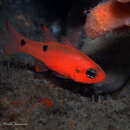Life Cycle
provided by Fishbase
Mouthbrooders (Ref. 240, 39366, 58874). Distinct pairing during courtship and spawning (Ref. 205).
Morphology
provided by Fishbase
Dorsal spines (total): 7; Dorsal soft rays (total): 9; Analspines: 2; Analsoft rays: 8
- Recorder
- Cristina V. Garilao
Trophic Strategy
provided by Fishbase
Commonly found on hard or semi-hard bottoms of the continental shelf (Ref. 9626); in harbors and around pilings and sea walls, out to outer reefs. Mobile invertebrates feeder (Ref. 57616). A planktivore species (Ref. 126840).
Biology
provided by Fishbase
Commonly found on hard or semi-hard bottoms of the continental shelf (Ref. 9626); in harbors and around pilings and sea walls, out to outer reefs.
Importance
provided by Fishbase
aquarium: commercial
Apogon pseudomaculatus
provided by wikipedia EN
The twospot cardinalfish (Apogon pseudomaculatus) is a species of fish in the family Apogonidae. It is found in the western Atlantic Ocean from southern Georgia to Sao Paulo, Brazil. A lionfish caught off Onslow Bay, North Carolina had a twospot cardinalfish in its gut contents and records from as far north as New England are most likely to be vagrants. It is also found in the eastern Atlantic from the islands of São Tomé and Príncipe in the Gulf of Guinea and Ascension Island.[1] It is common on hard or semi-hard substrates of the continental shelf such as in harbours, around pilings and over sea walls and offshore to the outer reefs. It is a mouthbrooder.[2] It is active at night and feeds on plankton.[1]
References
- Pamela Charney, Oral Brooding in the Cardinal-Fishes Phaeoptyx conklini and Apogon maculatus from the Bahamas, Copeia, Vol. 1976, No. 1 (Mar. 12, 1976), pp. 198–200.

- license
- cc-by-sa-3.0
- copyright
- Wikipedia authors and editors
Apogon pseudomaculatus: Brief Summary
provided by wikipedia EN
The twospot cardinalfish (Apogon pseudomaculatus) is a species of fish in the family Apogonidae. It is found in the western Atlantic Ocean from southern Georgia to Sao Paulo, Brazil. A lionfish caught off Onslow Bay, North Carolina had a twospot cardinalfish in its gut contents and records from as far north as New England are most likely to be vagrants. It is also found in the eastern Atlantic from the islands of São Tomé and Príncipe in the Gulf of Guinea and Ascension Island. It is common on hard or semi-hard substrates of the continental shelf such as in harbours, around pilings and over sea walls and offshore to the outer reefs. It is a mouthbrooder. It is active at night and feeds on plankton.
- license
- cc-by-sa-3.0
- copyright
- Wikipedia authors and editors
Distribution
provided by World Register of Marine Species
Western Atlantic: from New England to Bermuda, and Bahamas to southern Brazil, including the Gulf of Mexico, larvae stray into Canadian waters
North-West Atlantic Ocean species (NWARMS)
- license
- cc-by-4.0
- copyright
- WoRMS Editorial Board
Habitat
provided by World Register of Marine Species
nektonic
North-West Atlantic Ocean species (NWARMS)
- license
- cc-by-4.0
- copyright
- WoRMS Editorial Board
Habitat
provided by World Register of Marine Species
Commonly found on hard or semi-hard bottoms of the continental shelf; in harbors and around pilings and sea walls, out to outer reefs.
North-West Atlantic Ocean species (NWARMS)
- license
- cc-by-4.0
- copyright
- WoRMS Editorial Board

